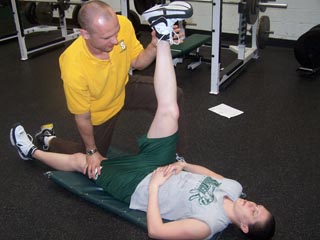The Fantastic Four Stretches
By: Dan Taylor
Unfortunately this article has nothing to do with beautiful, well muscled, superhuman people saving the world in spandex outfits! It is however a guideline to an important series of simple stretches that can do a great deal to aid in performance and injury reduction. There are obviously a myriad of stretches that can be executed dynamically or statically that help in the warming up or cooling down of an athletic population, some are sports specific and some are general. The four I present to you are basic in concept but powerful enough to impact everyone from the general populace all the way to elite level Basketball players.
The Stretches*:
- Supine Straight Leg Hamstring
- Supine Gluteus Maximus
- Supine Calf
- Supine Piriformis
*All stretches held for 20 seconds
None of these stretches are particularly ground breaking and the execution of a twenty second static hold is not going to rewrite the research data. However we need to understand exactly what the area is that we are stretching and why it is important. Ultimately they are all lower body and primarily hip based; this is the critical aspect behind their use. Power production is created through the hips and therefore without the correct length tension relationships, not only can power production be minimized but, reciprocal inhibition and synergistic dominance can take place leading to many possible injuries. Two main areas for concern is gluteal inhibition leading to hamstring pulls and weakness in the glute medius causing various knee complications.
“These Hips don’t lie”:
As much as it pains me to admit it, sports are not good for the body, granted they are exciting and can produce amazing highlights but on a purely physical level they can beat the athlete’s bodies up on a daily basis. The hips are critical in all sporting events and therefore they can absorb the brunt of the negative impact, be it sprinters producing maximal force in a linear fashion or a basketball player changing direction rapidly to keep up with a speedy defender. In my world of collegiate athletics another big culprit is the requirement of sitting down in class and during study time; once again the hips are placed at risk of tightening up and causing issues.
Plan of action:
These stretches done in sequence only take a few minutes per athlete and although I tend to do them assisted, most athletes can pick them up and perform them on their own to and almost equal level of success.
1. Supine Straight Leg Hamstring
 Hyperactivity in the hamstring complex can contribute to lower back and knee pain; they are also big contributor to restricted stride length in walking or running changing gait and leading to injury (1). The basic set-up of this stretch is to have the athlete lie supine and raise the leg you are about to stretch. Key points here are making sure the opposite leg is pinned as close to the floor as possible, if you allow this leg to raise the pelvis has a chance to rotate posteriorly negating the effectiveness of the leg being stretched. Stop if the athlete shows signs of more than mild discomfort and if you come to a point where you feel excessive resistance in the muscle. Forcing the leg up quickly and forcefully will stimulate the muscle spindles and create a contraction response further tightening the hamstring making the stretch pointless. (2)
Hyperactivity in the hamstring complex can contribute to lower back and knee pain; they are also big contributor to restricted stride length in walking or running changing gait and leading to injury (1). The basic set-up of this stretch is to have the athlete lie supine and raise the leg you are about to stretch. Key points here are making sure the opposite leg is pinned as close to the floor as possible, if you allow this leg to raise the pelvis has a chance to rotate posteriorly negating the effectiveness of the leg being stretched. Stop if the athlete shows signs of more than mild discomfort and if you come to a point where you feel excessive resistance in the muscle. Forcing the leg up quickly and forcefully will stimulate the muscle spindles and create a contraction response further tightening the hamstring making the stretch pointless. (2)
2. Supine Gluteus Maximus
 After the hamstring has been stretched for 20seconds the knee of the leg is bent and force is applied through the foot, keeping the knee and ankle in a straight line creating length in the glutes. The Gluteus Maximus is a strong mover of the hip and is often overlooked as part of a co contraction pattern with the iliopsoas; therefore this stretch is useful for normalizing the tone of the glutes. (1) Generally speaking the gluteal complex tends to have poor neural drive in most individuals due to the tightness of the hip flexors which comes from the aforementioned sitting in class and being flexed at the hip during sporting activities.
After the hamstring has been stretched for 20seconds the knee of the leg is bent and force is applied through the foot, keeping the knee and ankle in a straight line creating length in the glutes. The Gluteus Maximus is a strong mover of the hip and is often overlooked as part of a co contraction pattern with the iliopsoas; therefore this stretch is useful for normalizing the tone of the glutes. (1) Generally speaking the gluteal complex tends to have poor neural drive in most individuals due to the tightness of the hip flexors which comes from the aforementioned sitting in class and being flexed at the hip during sporting activities.
3. Supine Calf
 Although this particular muscle group has no direct impact on the hip area, due to the force couple relationships that run up and down the posterior chain it is vital that the calf complex has optimal flexibility so as not to create issues further up the kinetic chain. The angle of the knee can be changed slightly whilst stretching so both the soleus and gastrocnemius can be lengthened.
Although this particular muscle group has no direct impact on the hip area, due to the force couple relationships that run up and down the posterior chain it is vital that the calf complex has optimal flexibility so as not to create issues further up the kinetic chain. The angle of the knee can be changed slightly whilst stretching so both the soleus and gastrocnemius can be lengthened.
4. Supine Piriformis
 The piriformis is one of the main hip rotators and is critical in the eccentric deceleration, internal rotation and adduction of the femur. Some research has shown that aside from its main job as a rotator it may be more important as a postural muscle, acting to stabilize the spine due to its attachment on the sacrum (1). I am yet to come across an athlete that is not tight in this area due to the excessive rotation of the hips in almost all sporting events. Once again tightness in this area will be displayed as lower back discomfort.
The piriformis is one of the main hip rotators and is critical in the eccentric deceleration, internal rotation and adduction of the femur. Some research has shown that aside from its main job as a rotator it may be more important as a postural muscle, acting to stabilize the spine due to its attachment on the sacrum (1). I am yet to come across an athlete that is not tight in this area due to the excessive rotation of the hips in almost all sporting events. Once again tightness in this area will be displayed as lower back discomfort.
All of the stretches are to be held for twenty seconds at a minimum and constant feedback from the athlete to do with levels of discomfort and to ensure they are feeling the stretches correctly are critical to a successful session. As I said this particular “Fantastic Four” may not save the day, but they certainly will help improve your athlete’s performance.
Recommended Athletes' Acceleration
Products
References:
McAtee, R. E., & J. Charland. (2007). Facilitated Stretching 3RD Ed. Champaign, IL: Human Kinetics.
pp. 38, 43 & 61
Clark, M., et al. (2004). NASM Performance Enhancement Specialist. Calabassas, CA: NASM. p.203
Dan Taylor
Head Strength and Conditioning Coach
Siena College
www.siena.edu




1 Comment for “The Fantastic Four Stretches”